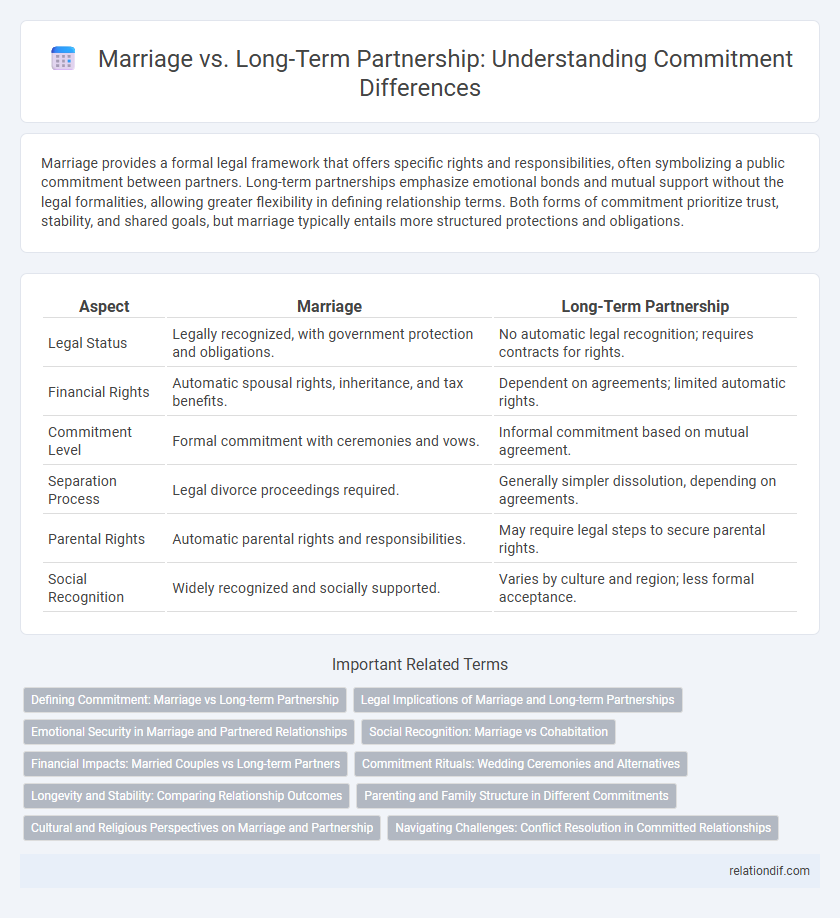Marriage provides a formal legal framework that offers specific rights and responsibilities, often symbolizing a public commitment between partners. Long-term partnerships emphasize emotional bonds and mutual support without the legal formalities, allowing greater flexibility in defining relationship terms. Both forms of commitment prioritize trust, stability, and shared goals, but marriage typically entails more structured protections and obligations.
Table of Comparison
| Aspect | Marriage | Long-Term Partnership |
|---|---|---|
| Legal Status | Legally recognized, with government protection and obligations. | No automatic legal recognition; requires contracts for rights. |
| Financial Rights | Automatic spousal rights, inheritance, and tax benefits. | Dependent on agreements; limited automatic rights. |
| Commitment Level | Formal commitment with ceremonies and vows. | Informal commitment based on mutual agreement. |
| Separation Process | Legal divorce proceedings required. | Generally simpler dissolution, depending on agreements. |
| Parental Rights | Automatic parental rights and responsibilities. | May require legal steps to secure parental rights. |
| Social Recognition | Widely recognized and socially supported. | Varies by culture and region; less formal acceptance. |
Defining Commitment: Marriage vs Long-term Partnership
Marriage legally binds partners through formal vows and recognized rights, establishing clear obligations and societal recognition. Long-term partnerships rely on mutual trust and emotional dedication without formal legal frameworks, allowing for flexible definitions of commitment. Both forms emphasize sustained support and loyalty, but marriage often includes legally enforceable responsibilities and protections absent in informal partnerships.
Legal Implications of Marriage and Long-term Partnerships
Marriage provides legally binding rights and obligations, including tax benefits, inheritance rights, and decision-making authority in medical situations, which long-term partnerships often lack without formal agreements. Legal recognition of marriage facilitates easier access to spousal benefits, social security survivor benefits, and immigration rights, whereas long-term partners may need to establish power of attorney or cohabitation agreements to secure similar protections. Couples in long-term partnerships face varying state or country laws that can complicate property division and custody rights compared to the clearer legal framework available to married couples.
Emotional Security in Marriage and Partnered Relationships
Emotional security in marriage and long-term partnerships fosters trust, stability, and deep connection, essential for enduring commitment. Marriages often provide formal frameworks reinforcing emotional safety through legal and social recognition, while partnered relationships rely more heavily on mutual understanding and communication to build similar security. Both relationship types benefit from consistent emotional support, vulnerability, and shared experiences that strengthen commitment over time.
Social Recognition: Marriage vs Cohabitation
Marriage offers formal social recognition through legal documentation, conferring rights and social status often absent in long-term cohabitation. Cohabiting couples may face limitations in areas such as inheritance, healthcare decisions, and social benefits without the legal framework marriage provides. Social norms and institutional policies frequently prioritize married couples, influencing public perception and access to societal resources.
Financial Impacts: Married Couples vs Long-term Partners
Married couples often benefit from legal financial protections such as joint tax filing, inheritance rights, and spousal benefits, which can lead to significant savings and wealth accumulation over time. Long-term partners may face challenges accessing similar financial advantages without formal marriage, potentially resulting in higher tax liabilities and limited access to spousal benefits like Social Security or health insurance. Understanding these financial distinctions is crucial for couples choosing between marriage and long-term partnerships to optimize economic security and planning.
Commitment Rituals: Wedding Ceremonies and Alternatives
Commitment rituals in marriage often involve formal wedding ceremonies with vows, rings, and legal recognition, symbolizing a public declaration of lifelong dedication. Long-term partnerships may choose personalized alternatives such as commitment ceremonies, cohabitation agreements, or renewal of vows that emphasize mutual promises without legal bindings. These rituals, whether traditional or customized, reinforce emotional bonds and shared responsibilities between partners.
Longevity and Stability: Comparing Relationship Outcomes
Marriage often provides legal and social frameworks that contribute to greater longevity and stability compared to long-term partnerships. Studies show married couples experience higher rates of financial security, shared assets, and access to healthcare benefits, which positively impact relationship durability. Long-term partnerships may lack these formal protections, potentially increasing vulnerability to external stressors and reducing overall stability.
Parenting and Family Structure in Different Commitments
Marriage typically provides a legally recognized framework that can simplify parenting responsibilities, custody rights, and inheritance issues compared to long-term partnerships. Long-term partnerships often require additional legal arrangements to ensure parental rights and family stability, which can vary widely depending on jurisdiction. Both commitment types emphasize co-parenting and family structure, but marriage offers more standardized protections and social recognition for raising children.
Cultural and Religious Perspectives on Marriage and Partnership
Marriage holds profound cultural and religious significance, often symbolizing a sacred covenant endorsed by traditions and faiths worldwide. Many religions, such as Christianity, Islam, and Hinduism, prescribe specific rituals and legal frameworks that define marital commitment, emphasizing permanence and family continuity. In contrast, long-term partnerships may lack formal religious endorsement but increasingly gain acceptance in diverse societies, reflecting evolving cultural norms toward personal autonomy and inclusive definitions of commitment.
Navigating Challenges: Conflict Resolution in Committed Relationships
Effective conflict resolution in committed relationships hinges on open communication, empathy, and mutual respect, whether in marriage or long-term partnerships. Couples who actively listen and address issues promptly tend to build stronger bonds and foster deeper understanding. Structured strategies like setting boundaries, seeking compromise, and occasionally engaging professional counseling enhance resilience and commitment over time.
marriage vs long-term partnership Infographic

 relationdif.com
relationdif.com